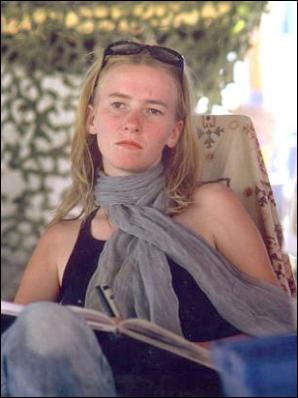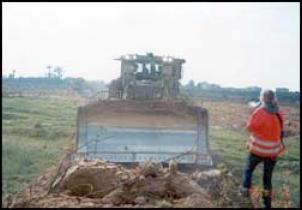Tribute to Rachel Corrie: One Year After
By the International Press Center (IPC)
Rachel Corrie, an American peace activist who was killed one year ago by the Israeli occupying forces in the southern Gaza Strip city of Rafah, after being crushed to death by an Israeli military bulldozer near the Palestinian-Egyptian borders.

On March 16, 2003, IOF claimed that the driver of the bulldozer could not see Rachel, yet all the pictures that were published on TVs and newspapers showed that Rachel was standing on a heap of sand in front of a Palestinian-owned house in Rafah and wearing distinguishable bright clothes when the bulldozer came to demolish that house.
Rachel, according to eyewitnesses who were in the scene, was wearing an orange jacket, and that she pointed at the Bulldozer’s driver, appealing to him not to crush the house, but he continued driving till he crushed her to death.

Rachel Corrie moments before the Israeli bulldozer deliberately ran over the top of her. SM: Scoop Co-Editor.
Three doctors of the local Palestinian hospital of Abu Yousef Alnajjar examined Rachel’s body and confirmed that the cause of her death was suffocation due to being buried under sand as well as various fractures in different parts of her body, a fact that indicates she was crushed by the Israeli bulldozer.

Rachel later died from injuries sustained in this attack. SM: Scoop Co-Editor.
Despite all the said facts behind Rachel’s death, the US State Department spokesman voiced his "regret" for the loss of an American citizen, saying that the US concerned bodies had made the required contacts with the Israeli authorities.
A year after this atrocious crime that was committed in public, the case of Rachel Corrie's murder must be opened again to reaffirm the perpetrator's crime and document it for the generations to come.
Joseph Smith, one of the American peace activists and an eyewitness to Rachel's murder, said that about 2:00 p.m. local time, he observed a group of International Solidarity Movement (ISM) members marching towards the area where the murder occurred, in the Al Salam neighborhood in Rafah City. He added that the group were very worried that the Israeli bulldozer might tear down one of the houses there, so they took shelter in this house and tried to disrupt the work of the bulldozer.
"There were eight ISM activists, and they confronted the bulldozer. One of those activists was Rachel, who stood in front of the bulldozer for nearly 45 minutes, standing only 20-30 meters away from it," Smith said.
"Rachel was wearing a bright orange jacket, and was shouting very loud at the driver of the bulldozer, waving her hand many times. The driver just kept driving in and crushed her. During that time, the other ISM members began to scream and wave to the driver, asking him to stop and go back from above Rachel, who disappeared under the huge bulldozer."
Smith continued by saying that when the bulldozers turned back, Rachel was clearly buried under the sand, and that the ISM activists called the Palestinian paramedics.
Drag, another peace activist who was a witness to the murder, said that Rachel was standing in front of the house of Dr. Samir Nasrallah, who is in a good relationship with her for three months. Drag insisted that it was impossible for the driver of the bulldozer not to see Corrie, who was wearing a bright orange jacket.
"Rachel insisted on not leaving the area despite that the bulldozer was becoming nearer and nearer to her, especially that she is tightly connected to the residents of the house the bulldozer was going to demolish. She remained there while the earth was shaking under her legs. She kneeled on her legs on a mound of sand. The mound lifted her up to become in the same level with the bulldozer driver. She suddenly sank into the sand while the bulldozer was continuing to move towards her, until she disappeared under its fork."
Drag further said that all the other activists rushed towards where she was, screaming at the driver to stop, but the driver reversed and then moved forward again to run over her a second time. "When we arrived there, Rachel's lower half was covered with sand, and her lip was cut badly and was bleeding severely. She was barely able to speak, and only said, 'my back is broken'. We tried to help her and ask her to breathe. We told her that we love her. We noticed that her condition was deteriorating fast. 15 minutes later the medical crews arrived and rushed her to a hospital."
Drag remarked in a letter published by the Herald Tribune on March 17, 2003 that the Israeli occupying forces have committed two crimes that day by killing Rachel and demolishing houses.
On the other hand, Elizabeth Corrie, Rachel's cousin, pointed out in a letter published on the ISM website on March 3, 2004 that Rachel was crushed under an American-made "Caterpillar" bulldozer, which was sent to Israel as part of the annual, $3-4 billion, American assistance to Israel, and are deducted from US tax payers' money.
Elizabeth added that "the use of American bulldozers to tear down houses without speaking about the unarmed human rights and peace activists who are being crushed under these bulldozers is a violation to the United States law, including the weapons export monitoring law, which prohibits offering military assistance to countries that use it against civilians."
She added that the exemption of the Israeli forces from the responsibility of Rachel's death and the Israeli government's categorical rejection to an independent investigation of the murder further sheds the light on Sharon's administration that refused to take responsibility towards an American citizen's death, with the collaboration of the American President Bush who allowed a foreign country to commit a crime against US citizens unpunished.
The Palestinian people, and in honor of Rachel's ultimate sacrifice to protect them and protect their rights, have named many establishments after her, including a street in the city of Rafah, a cultural center and a kindergarten.


 Richard D. Wolff, IMI: Political Economy Contradictions As We Lurch Into 2025
Richard D. Wolff, IMI: Political Economy Contradictions As We Lurch Into 2025 People with Disability Australia - PWDA: CMHA And PWDA Demand Justice And Urgent Reform Following Death Of Simon Cartwright At Silverwater Jail
People with Disability Australia - PWDA: CMHA And PWDA Demand Justice And Urgent Reform Following Death Of Simon Cartwright At Silverwater Jail UNICEF Aotearoa NZ: Vanuatu Quake - UNICEF Aotearoa Launches Urgent Fundraising Appeal For 40,000 Children In Need
UNICEF Aotearoa NZ: Vanuatu Quake - UNICEF Aotearoa Launches Urgent Fundraising Appeal For 40,000 Children In Need New Zealand Defence Force: Surveillance, Aid, Responders And Evacuees Covered By RNZAF Vanuatu Flights
New Zealand Defence Force: Surveillance, Aid, Responders And Evacuees Covered By RNZAF Vanuatu Flights Leonard C. Goodman, IMI: The Democratic Party Faces Its Day Of Reckoning
Leonard C. Goodman, IMI: The Democratic Party Faces Its Day Of Reckoning APEC: Korea Sets Ambitious Priorities For APEC 2025 - Building A Sustainable Tomorrow
APEC: Korea Sets Ambitious Priorities For APEC 2025 - Building A Sustainable Tomorrow